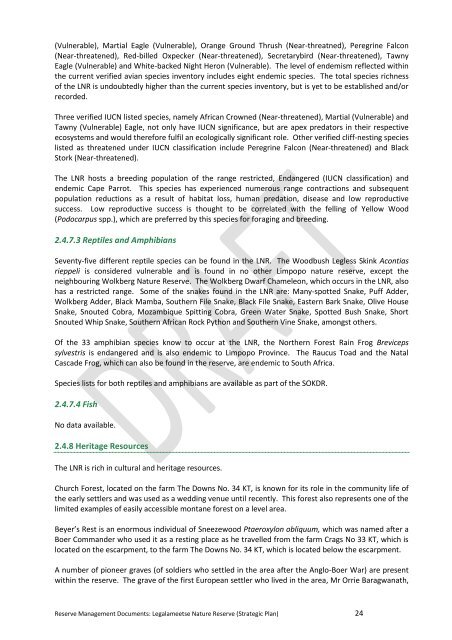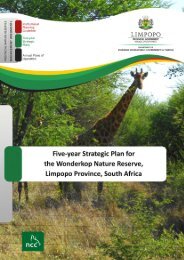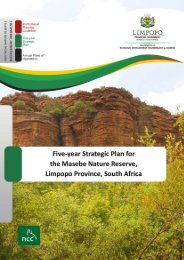Guiding principles for reserve management - NCC Environmental ...
Guiding principles for reserve management - NCC Environmental ...
Guiding principles for reserve management - NCC Environmental ...
- No tags were found...
You also want an ePaper? Increase the reach of your titles
YUMPU automatically turns print PDFs into web optimized ePapers that Google loves.
(Vulnerable), Martial Eagle (Vulnerable), Orange Ground Thrush (Near-threatned), Peregrine Falcon(Near-threatened), Red-billed Oxpecker (Near-threatened), Secretarybird (Near-threatened), TawnyEagle (Vulnerable) and White-backed Night Heron (Vulnerable). The level of endemism reflected withinthe current verified avian species inventory includes eight endemic species. The total species richnessof the LNR is undoubtedly higher than the current species inventory, but is yet to be established and/orrecorded.Three verified IUCN listed species, namely African Crowned (Near-threatened), Martial (Vulnerable) andTawny (Vulnerable) Eagle, not only have IUCN significance, but are apex predators in their respectiveecosystems and would there<strong>for</strong>e fulfil an ecologically significant role. Other verified cliff-nesting specieslisted as threatened under IUCN classification include Peregrine Falcon (Near-threatened) and BlackStork (Near-threatened).The LNR hosts a breeding population of the range restricted, Endangered (IUCN classification) andendemic Cape Parrot. This species has experienced numerous range contractions and subsequentpopulation reductions as a result of habitat loss, human predation, disease and low reproductivesuccess. Low reproductive success is thought to be correlated with the felling of Yellow Wood(Podocarpus spp.), which are preferred by this species <strong>for</strong> <strong>for</strong>aging and breeding.2.4.7.3 Reptiles and AmphibiansSeventy-five different reptile species can be found in the LNR. The Woodbush Legless Skink Acontiasrieppeli is considered vulnerable and is found in no other Limpopo nature <strong>reserve</strong>, except theneighbouring Wolkberg Nature Reserve. The Wolkberg Dwarf Chameleon, which occurs in the LNR, alsohas a restricted range. Some of the snakes found in the LNR are: Many-spotted Snake, Puff Adder,Wolkberg Adder, Black Mamba, Southern File Snake, Black File Snake, Eastern Bark Snake, Olive HouseSnake, Snouted Cobra, Mozambique Spitting Cobra, Green Water Snake, Spotted Bush Snake, ShortSnouted Whip Snake, Southern African Rock Python and Southern Vine Snake, amongst others.Of the 33 amphibian species know to occur at the LNR, the Northern Forest Rain Frog Brevicepssylvestris is endangered and is also endemic to Limpopo Province. The Raucus Toad and the NatalCascade Frog, which can also be found in the <strong>reserve</strong>, are endemic to South Africa.Species lists <strong>for</strong> both reptiles and amphibians are available as part of the SOKDR.2.4.7.4 FishNo data available.2.4.8 Heritage ResourcesThe LNR is rich in cultural and heritage resources.Church Forest, located on the farm The Downs No. 34 KT, is known <strong>for</strong> its role in the community life ofthe early settlers and was used as a wedding venue until recently. This <strong>for</strong>est also represents one of thelimited examples of easily accessible montane <strong>for</strong>est on a level area.Beyer’s Rest is an enormous individual of Sneezewood Ptaeroxylon obliquum, which was named after aBoer Commander who used it as a resting place as he travelled from the farm Crags No 33 KT, which islocated on the escarpment, to the farm The Downs No. 34 KT, which is located below the escarpment.A number of pioneer graves (of soldiers who settled in the area after the Anglo-Boer War) are presentwithin the <strong>reserve</strong>. The grave of the first European settler who lived in the area, Mr Orrie Baragwanath,Reserve Management Documents: Legalameetse Nature Reserve (Strategic Plan) 24

















